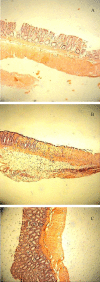Comparative Study of Berberis vulgaris Fruit Extract and Berberine Chloride Effects on Acetic Acid-Induced Colitis in Rats
- PMID: 24363687
- PMCID: PMC3869597
Comparative Study of Berberis vulgaris Fruit Extract and Berberine Chloride Effects on Acetic Acid-Induced Colitis in Rats
Abstract
Antioxidant and immunomodulatory effects of anthocyanins are abundant in berberry fruits suggesting that they may have beneficial effects on inflammatory bowel diseases (IBD). The present study was carried out to investigate the anti-colitic effect of Berberis vulgaris fruit extract (BFE) compared to berberine chloride (BEC) and corticosteroids using an animal model of acetic acid induced experimental colitis. BFE with three different doses (375, 750, and 1500 mg/Kg) was administered orally or rectally prior to ulcer induction. BEC (10 mg/Kg), prednisolone (5 mg/Kg), hydrocortisone acetate enema (20 mg/Kg) and normal saline (5 mL/Kg) were considered as respective controls. The tissue was assessed macroscopically for damage scores, area, index and weight/length ratio. They were also examined histopathologically for inflammation extent and severity, crypt damage, invasion involvement and total colitis index. Results indicated that greater doses of oral BFE (750, 1500 mg/Kg) as well as BEC (10 mg/Kg) were effective to protect against colonic damage. By rectal pretreatment, the extract was only effective to diminish the ulcer index and the efficacy was not significant for mucosal inflammation parameters. In conclusion BFE, which is nearly devoid of berberine, was effective to protect against colitis and this might be attributed to its anthocyanin constituents.
Keywords: Barberry fruit extract; Berberine; Berberis vulgaris; Colitis; Rats.
Figures


References
-
- Chrousos GP. Adrenocorticosteroids and adrenocortical antagonists. In: Katzung BG, editor. Basic and Clinical Pharmacology. 10th ed. New York : McGraw Hill Companies; 2007. pp. 909–10.
-
- Sellin JH, Pasricha PJ. Pharmacotherapy of inflammatory bowel diseases. In: Brunton LL, Lazo JS, Parker KL, editors. Goodman and Gilmans’ the Pharmacological Basis of Therapeutics. 11th ed. New York: McGraw-Hill companies; 2006. pp. 1009–1011.
-
- Aghbashlo M, Kianmehr MH, Hassan-Beigi SR. Specific heat and thermal conductivity of berberris fruit (Berberis vulgaris) Am. J. Agric. Biol. Sci. 2008;3:330–336.
-
- Aynechi Y. Pharmacognosy and Medicinal Plants of Iran. Tehran : Tehran University Press; 1991. pp. 1041–42.
-
- Souri E, Amin GH, Dehmobed-Sharifabadi A, Nazifi A, Farsam H. Antioxidant activity of sixty plants from Iran. Iranian J. Pharm. Res. 2004;3:55–59.
LinkOut - more resources
Full Text Sources
